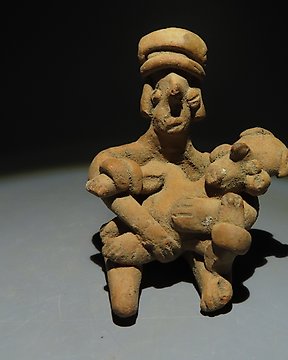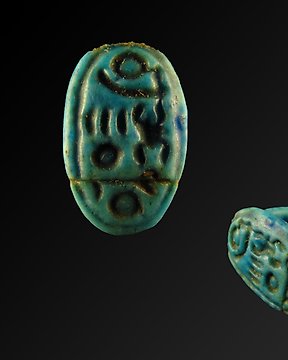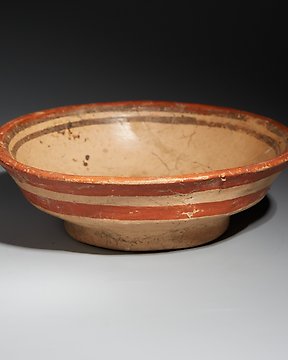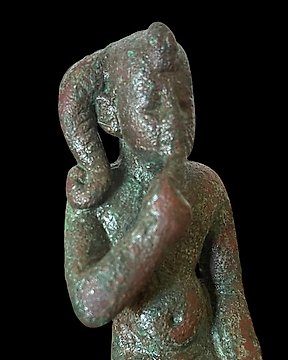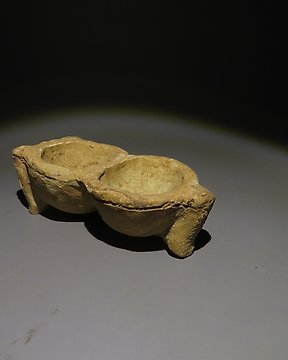Very nice and fine cut little jewel! Well packed too! Thanks!
Προβολή μετάφρασηςΑρχαία Αιγυπτιακή Μπρούντζος Άγαλμα του θεού Imhotep. Ύστερη Περίοδος, 664 - 332 π.Χ. 2,6 cm Υ.
Αρ. 84870935
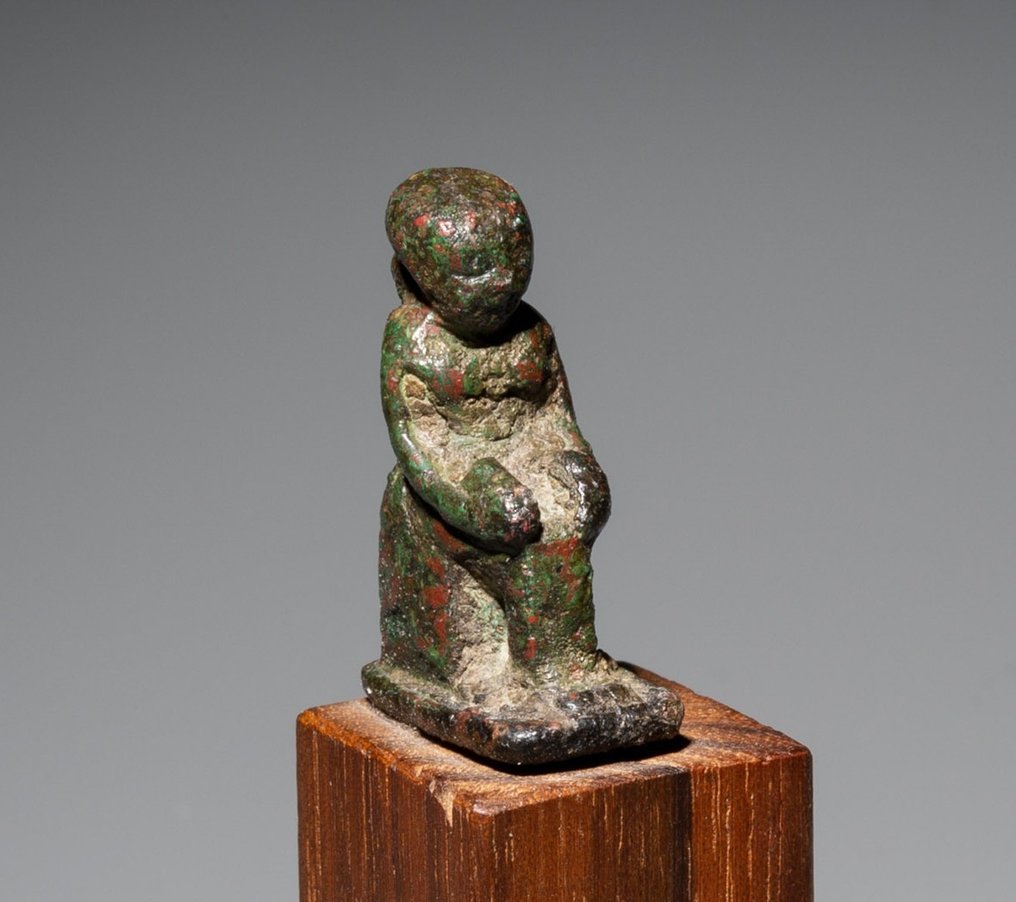




Statue of the god Imhotep
- very rare -
CULTURE: Ancient Egypt
PERIOD: Late Period, 664 - 332 BC.
MATERIAL: Solid Bronze
DIMENSIONS: 2.6 cm height and 6 cm height with the stand.
PROVENANCE: Private collection, Paris, France. Collected since 60's-70's.
CONDITION: Intact.
DESCRIPTION:
Hero and god of medicine, Asclepios was worshiped in Greece and later in Rome under the name of Aesculapius. He was the son of Apollo and Coronis, and the father of Hygía (goddess of hygiene), Yaso (goddess of recovery from illness), Aceso (goddess of the healing process), Aegle (goddess of good health) and Panacea (goddess of healing). universal remedy). Likewise, his figure was associated with the Roman-Etruscan god Vediovis and the Egyptian Imhotep. According to mythological narratives, Aesculapius received his first medical teachings from his father, Apollo, although he was later instructed in the art of medicine by the centaur Chiron, and received secret knowledge from a serpent, a sacred animal in Greece and associated with to wisdom, healing and resurrection. Other versions narrate that, when he was ordered to bring Glaucus back to life, he was confined in a secret prison. There a snake climbed up his staff and the god, lost in thought, unconsciously hit the staff on the ground and killed the animal. A second snake then appeared, carrying a grass in its mouth; he placed it on the head of his dead sister and she was resurrected. Seeing this, Asclepios used the same plant to bring Glaucus back from the dead.
During his lifetime, Aesculapius became the most renowned physician, surpassing not only Chiron but also his own father, the divine Apollo, and was thereby awarded the power to bring the dead back to life. Hades, irritated to see that many of his subjects were taken from him, complained to his brother Zeus. Other sources explain instead that the King of Olympus was concerned that he teach the art of resurrection to other human beings. In any case, Zeus ended the life of Aesculapius with one of his fearsome thunderbolts, although, thanks to the intervention of Apollo, he finally granted him divinity and gave him a place on Olympus.
The rod of Aesculapius, the main iconographic attribute of the god, is one of the motifs of Classical Antiquity whose symbolism endures to this day. Although the serpent has a radically opposite meaning in Western Christian culture, for the Greeks it was a healing animal; its ability to shed its skin symbolized eternity and the restoration of life and health. The Rod of Asclepius is today a symbol of the medical profession on five continents, as well as of the World Health Organization.
The cult of Asclepius/Aesculapius dates back to Hellenistic Greece, and by the 5th century B.C. we already find it fully established, with the city of Epidaurus as its main center, although there were also important sanctuaries dedicated to the god on the island of Cos, Thessaly and Pergamon. In the year 420 B.C. A sanctuary was dedicated to him in Athens, located in the southern part of the Acropolis, next to a fountain. The sick believed that they could recover by sleeping in these temples, which in fact combined the functions of sanctuary and hospital and in which the Asclepius snakes (Zamenis longissimus) lived freely and were respected as sacred animals. His cult was continued by the Romans, and in fact Ovid, in his Metamorphoses, relates that during the plague epidemic of 293 B.C. Rome sent an embassy to Epidaurus to bring back Aesculapius, the only one capable of saving the city. The god then appeared in the form of a serpent and jumped into the sea.
Notes:
- The piece includes authenticity certificate.
- The piece includes Spanish Export License.
- The seller guarantees that he acquired this piece according to all national and international laws related to the ownership of cultural property. Provenance statement seen by Catawiki.
Ιστορία πωλητή
Statue of the god Imhotep
- very rare -
CULTURE: Ancient Egypt
PERIOD: Late Period, 664 - 332 BC.
MATERIAL: Solid Bronze
DIMENSIONS: 2.6 cm height and 6 cm height with the stand.
PROVENANCE: Private collection, Paris, France. Collected since 60's-70's.
CONDITION: Intact.
DESCRIPTION:
Hero and god of medicine, Asclepios was worshiped in Greece and later in Rome under the name of Aesculapius. He was the son of Apollo and Coronis, and the father of Hygía (goddess of hygiene), Yaso (goddess of recovery from illness), Aceso (goddess of the healing process), Aegle (goddess of good health) and Panacea (goddess of healing). universal remedy). Likewise, his figure was associated with the Roman-Etruscan god Vediovis and the Egyptian Imhotep. According to mythological narratives, Aesculapius received his first medical teachings from his father, Apollo, although he was later instructed in the art of medicine by the centaur Chiron, and received secret knowledge from a serpent, a sacred animal in Greece and associated with to wisdom, healing and resurrection. Other versions narrate that, when he was ordered to bring Glaucus back to life, he was confined in a secret prison. There a snake climbed up his staff and the god, lost in thought, unconsciously hit the staff on the ground and killed the animal. A second snake then appeared, carrying a grass in its mouth; he placed it on the head of his dead sister and she was resurrected. Seeing this, Asclepios used the same plant to bring Glaucus back from the dead.
During his lifetime, Aesculapius became the most renowned physician, surpassing not only Chiron but also his own father, the divine Apollo, and was thereby awarded the power to bring the dead back to life. Hades, irritated to see that many of his subjects were taken from him, complained to his brother Zeus. Other sources explain instead that the King of Olympus was concerned that he teach the art of resurrection to other human beings. In any case, Zeus ended the life of Aesculapius with one of his fearsome thunderbolts, although, thanks to the intervention of Apollo, he finally granted him divinity and gave him a place on Olympus.
The rod of Aesculapius, the main iconographic attribute of the god, is one of the motifs of Classical Antiquity whose symbolism endures to this day. Although the serpent has a radically opposite meaning in Western Christian culture, for the Greeks it was a healing animal; its ability to shed its skin symbolized eternity and the restoration of life and health. The Rod of Asclepius is today a symbol of the medical profession on five continents, as well as of the World Health Organization.
The cult of Asclepius/Aesculapius dates back to Hellenistic Greece, and by the 5th century B.C. we already find it fully established, with the city of Epidaurus as its main center, although there were also important sanctuaries dedicated to the god on the island of Cos, Thessaly and Pergamon. In the year 420 B.C. A sanctuary was dedicated to him in Athens, located in the southern part of the Acropolis, next to a fountain. The sick believed that they could recover by sleeping in these temples, which in fact combined the functions of sanctuary and hospital and in which the Asclepius snakes (Zamenis longissimus) lived freely and were respected as sacred animals. His cult was continued by the Romans, and in fact Ovid, in his Metamorphoses, relates that during the plague epidemic of 293 B.C. Rome sent an embassy to Epidaurus to bring back Aesculapius, the only one capable of saving the city. The god then appeared in the form of a serpent and jumped into the sea.
Notes:
- The piece includes authenticity certificate.
- The piece includes Spanish Export License.
- The seller guarantees that he acquired this piece according to all national and international laws related to the ownership of cultural property. Provenance statement seen by Catawiki.
Ιστορία πωλητή
- 746
- 7
- 0
nice piece and very fast shipping!
Προβολή μετάφρασηςEs una maravilla de moneda, donde se le nota los pasos de los años y me encanta. Servido muy rápido y bien empaquetado. Con su certificación. Qué más se puede pedir?
Προβολή μετάφρασηςSnelle en correcte levering, alleen was de verpakking voor het schilderij niet stevig genoeg.
Προβολή μετάφρασηςHerzlichen Dank!
Προβολή μετάφρασηςAll OK and with very fast shipping.
Προβολή μετάφρασηςPrachtig schilderij. Zo blij mee. Zeer nette verkoper en zeer snelle levering.
Προβολή μετάφρασηςperfect ! very fast and high quality delivery !
Προβολή μετάφρασηςAll well! Thanks.
Προβολή μετάφρασηςVendeur très professionnel, top +++×
Προβολή μετάφρασηςPhotos trop contrastées pour bien percevoir les défauts, mais ces défauts étaient visibles pour autant. Le "Bon état" est trompeur. Sinon, envoi rapide et correctement emballé. Frais de port exagérés.
Προβολή μετάφρασηςGreat communication, delivery and product. Came with a well made certificate of authenticity and good packaging. Overall very happy with the purchase! Delivery is a bit expensive, but I recommend it
Προβολή μετάφρασηςMagnifique témoin du passé, envoyé avec tous les justificatifs, impeccable. Encore une fois très satisfait, un grand merci
Προβολή μετάφρασηςThank you for the Special offer and the fast shipping of this excellent piece of art!
Προβολή μετάφρασηςvery good description of the object, very good price for this rare item,. Fast sending (has been at my place 2 days after buying!). Definitely would buy again.
Προβολή μετάφρασηςSehr schön
Προβολή μετάφρασηςAs described, perfect logistic
Προβολή μετάφρασηςgreat seller, everything came as should with certificate of authenticity
Προβολή μετάφρασηςExceptionally well packaged, description aligned with positing received
Προβολή μετάφρασηςReally precious, but without sound...
Προβολή μετάφρασηςPainting well packed and rapidly sent!
Προβολή μετάφρασηςsempre grande rapidità e professionalità
Προβολή μετάφρασηςparfait bien reçu, merci
Προβολή μετάφρασηςVery satisfied with the small Greek Lekythos. As always (we have already bought several items from Bagot), the object was wrapped and sent immediately and with the greatest care.
Προβολή μετάφρασηςPerfect, excellent condition, good packaging, the parcel arrived without any problems… all is perfect as usual. Thank you very much and wait for an other nice piece like this one. Gilles.
Προβολή μετάφρασης- 746
- 7
- 0
Very nice and fine cut little jewel! Well packed too! Thanks!
Προβολή μετάφρασης

